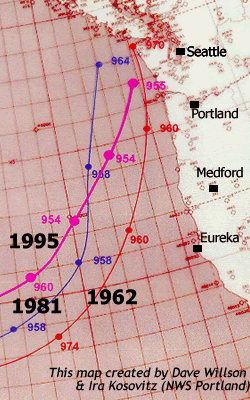
Pacific Northwest windstorms, sometimes colloquially known as Big Blows, [1] are extratropical cyclones which form in the Pacific basin, and affect land areas in the Pacific Northwest of the United States and British Columbia, Canada. They form as cyclonic windstorms associated with areas of low atmospheric pressure that track across the North Pacific Ocean towards western North America. Deep low pressure areas are relatively common over the North Pacific. They are most common in the winter months. On average, the month when most windstorms form is November or December.
Contents
The closest analogue to these storms are European windstorms, which develop over the eastern portion of the North Atlantic Ocean as opposed to the North Pacific. [2] Nor'easters, a similar class of extratropical cyclones, commonly affect the east coast of North America. While the storms on the East Coast are named "nor'easters", the Pacific Northwest windstorms are not called "nor'westers" because the cyclones' primary winds can blow from any direction, while the primary winds in nor'easters usually blow from the northeast. [3]
The largest storm events have struck the Pacific Northwest every 15 to 30 years according to modern records. Among the strongest were the 1962 Columbus Day storm, which formed from the remnants of Typhoon Frieda/Freda and killed 50 people; the 1993 Inauguration Day windstorm, which killed 6 people; and the 2006 Hanukkah Eve windstorm, which killed 14 people and caused widespread power outages for 11 days. [4]
